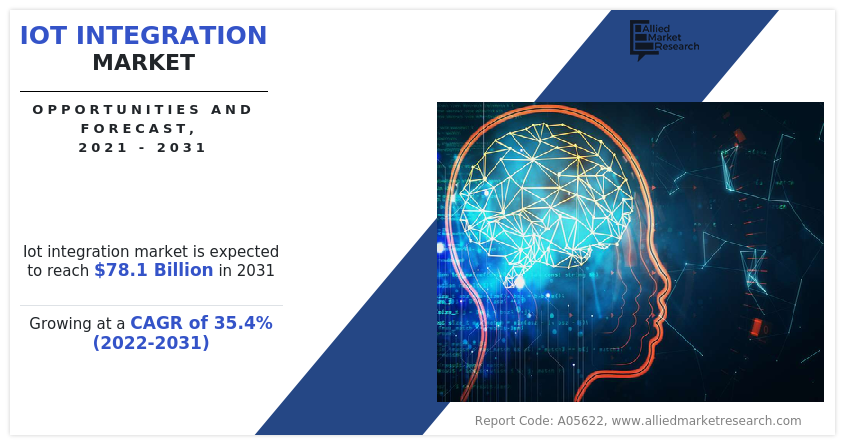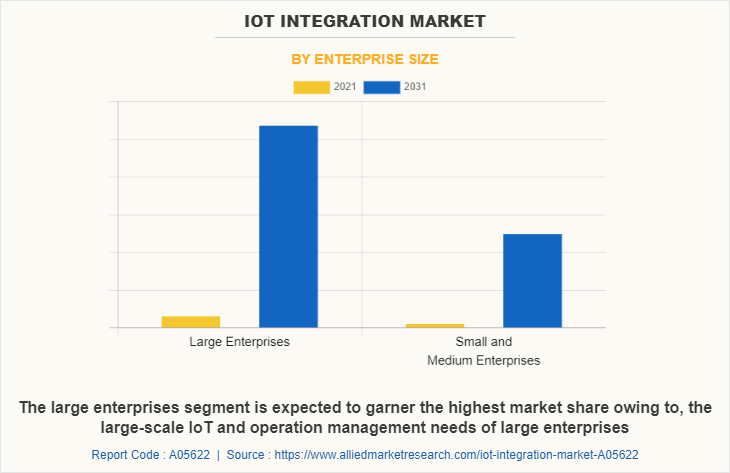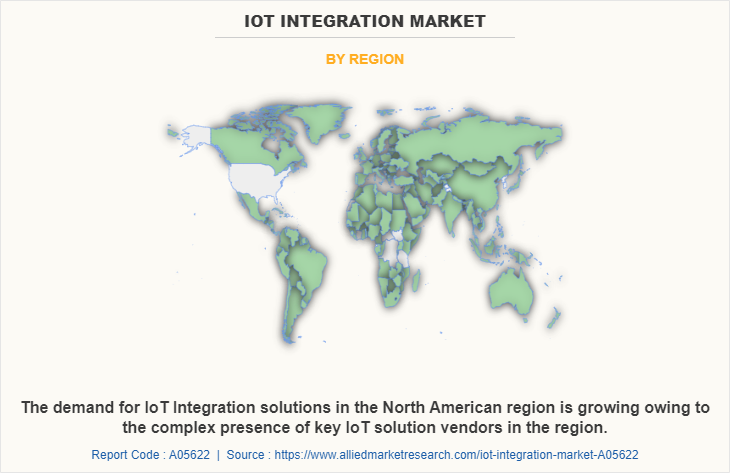IoT Integration Market Overview
The global iot integration market size was valued at USD 3.8 billion in 2021, and is projected to reach USD 78.1 billion by 2031, growing at a CAGR of 35.4% from 2022 to 2031.
Internet of Things (IoT) integration consists of a mix of new IoT devices, IoT data, IoT platforms, and IoT applications. The IoT integration market is defined as the set of IoT integration capabilities that IoT project implementers need to successfully integrate end-to-end IoT business solutions. The rise in demand for IoT applications is propelling the growth of the global IoT in the banking market. Furthermore, increasing penetration of IoT-powered smartphones and smart wearables is expected to aid in the growth of IoT solutions in the banking industry.

However, higher installation costs and complex infrastructural requirements can hamper the IoT integration market growth. Conversely, advancements in the field of IoT and cloud technology are expected to offer remunerative opportunities for the expansion of the IoT integration market during the forecast period. The iot integration market is segmented into Service Type, Enterprise Size and Industry Vertical.
Segment Review
The IoT integration industry is segmented on the basis of service type, enterprise size, industry vertical, and region. Based on service type, the market is segmented into system design services, device and platform management services, application management services, network management services, testing services, and others. Based on enterprise size, the market is segmented into large enterprises and small and medium enterprises. Depending on industry vertical, the market is classified into BFSI, Manufacturing, Healthcare, Government and Defense, Energy and Utilities, Automotive and Transportation, Retail and E-commerce, IT and Telecom, and others. Region wise, it is analyzed across North America, Europe, Asia-Pacific, and LAMEA.
Depending on enterprise size, the large enterprise segment dominated the IoT integration market share in 2021, and is expected to continue this trend during the forecast period owing to its large-scale operations needing highly efficient monitoring systems. However, the SME segment is expected to witness the highest growth in the upcoming years, owing to the growth in number of technological investments by small-scale businesses to make up for their smaller fleet of employees, which is anticipated to aid in the growth of the IoT integration industry.

Region-wise, the IoT integration market was dominated by North America in 2021, and is expected to retain its position during the forecast period, owing to high concentration of IoT integration solution vendors in the region, which is expected to drive the market for IoT integration technology during the forecast period. However, Asia-Pacific is expected to witness significant growth during the forecast period, owing to its growing digital and economic transformation and the developing communication network infrastructure in the region, which is expected to fuel the growth of IoT integration trends in the region in the coming few years.

The report focuses on growth prospects, restraints, and analysis of the global IoT integration market trends. The study provides Porter’s five forces analysis to understand the impact of various factors, such as bargaining power of suppliers, competitive intensity of competitors, threat of new entrants, threat of substitutes, and bargaining power of buyers on the global IoT integration market share.
Top Impacting Factors
Growing cloud adoption and digitization trends in modern industries
Cloud computing is an emerging technology, which allows enterprises to access and store data online. Agility, scalability, reliability, and flexibility are some of the major characteristics associated with cloud technology. Software as a service (SaaS) or on-demand services are some of the cloud computing service models, wherein users pay as per their usage. Cloud-based applications reduce the IT infrastructure cost of a company to some extent. This is the prime reason behind the increased adoption of cloud-based applications among companies. With mobiles becoming an integral part of individuals, enterprises are spending on cloud-connected mobile applications for easy access to information anytime and anywhere.
In addition, cloud-connected mobile applications allow individuals to synchronize, update, and control information. Furthermore, the adoption of cloud and mobile-enabled IoT is expected to rise in the future, which, in turn, is likely to propel the IoT integration market growth. In addition, IoT devices generate a massive volume of data per second. Cloud computing helps in the storage and analysis of this data so that enterprises can get the maximum benefit of an IoT infrastructure. Various players are launching cloud platforms specifically for IoT solutions.
For instance, in February 2021, Google Cloud collaborated with Sigfox to scale its cloud infrastructure and extend its IoT services portfolio. Through this partnership, Sigfox will be able to accelerate its Massive IoT plan, which is strategy to process billions of messages each month from objects connected to the internet using data stored on the cloud server. Such factors are pushing the growth of IoT integration in modern business environments.
Improving Communication Networks
As governments continue to try and enhance the present cellular networking infrastructure of their countries in order to improve communication speeds and overall connectivity for their citizens and the betterment of services, IoT applications are becoming easier to develop and deploy. This growth in many developing nations is helping newer businesses to invest in IoT applications. For instance, Ericsson, a Swedish telecommunications equipment, and services company, generated over $750 million in income in 2020 from the sale of telecom equipment and services in Southeast Asia and Australia. This was a 21% rise over the previous year of 2019. Such instances are highlighting the improving cellular connectivity, which in turn promises great opportunities for the growth of IoT-based applications in a variety of business sectors.
Moreover, modern communication technologies such as 5G communication networks that offer ultra-low latency and higher bandwidth, are empowering the use of real-time monitoring and communication systems, allowing industries to adopt automation and industry 4.0 trends. Such factors are promising great opportunities for the future of IoT integration in modern industrial applications.
Key Players
The key players profiled in the IoT integration market analysis are Accenture, ATOS SE, Capgemini, Cognizant, Dell Technology, DXC Technology, Fujitsu Limited, HCL Technologies, IBM Corporation, Infosys Limited, NTT data corporation, Salesforce Inc., Tech Mahindra, Tata Consultancy Services, Wipro, Deloitte, and Softdel. These players have adopted various strategies to increase their market penetration and strengthen their position in the industry.
COVID-19 Impact Analysis
The IoT integration market is expected to grow rapidly post the period of the pandemic, owing to the rise in the adoption of work-from-home culture across the globe. The IoT integration market has witnessed significant growth in the past few years; however, owing to the outbreak of the COVID-19 pandemic, banks were forced to rapidly shift their business toward digital platforms. This is attributed to the various lockdown and movement restrictions in public places by governments in a majority of countries, which helped to drive the market growth as various businesses sped up their digital transformation during the period to keep up with various social distancing and hygiene challenges during the period. Such factors supported the growth of the IoT integration market globally.
Key Benefits for Stakeholders
This report provides a quantitative analysis of the IoT Integration Market Forecast, current trends, estimations, and dynamics of the iot integration market analysis from 2021 to 2031 to identify the prevailing iot integration market opportunities.
The market research is offered along with information related to key drivers, restraints, and opportunities.
Porter's five forces analysis highlights the potency of buyers and suppliers to enable stakeholders make profit-oriented business decisions and strengthen their supplier-buyer network.
In-depth analysis of the iot integration market segmentation assists to determine the prevailing market opportunities.
Major countries in each region are mapped according to their revenue contribution to the global market.
Market player positioning facilitates benchmarking and provides a clear understanding of the present position of the market players.
The report includes the analysis of the regional as well as global iot integration market trends, key players, market segments, application areas, and market growth strategies.
IoT Integration Market Report Highlights
| Aspects | Details |
| Market Size By 2031 | USD 78.1 billion |
| Growth Rate | CAGR of 35.4% |
| Forecast period | 2021 - 2031 |
| Report Pages | 323 |
| By Service Type |
|
| By Enterprise Size |
|
| By Industry Vertical |
|
| By Region |
|
| Key Market Players | Fujitsu Limited, Deloitte, NTT data corporation, Dell Technology,, Cognizant, HCL Technologies Ltd, Softdel, Tech Mahindra, DXC Technology, Salesforce Inc., Capgemini, IBM Corporation, Infosys Limited, ATOS SE, Accenture plc, Tata Consultancy Services, Wipro |
Analyst Review
Demand for IoT integration systems has grown in the past few years, and the market is expected to maintain this trend in the coming years as well, owing to the increasing adoption of IoT in day-to-day life. Moreover, the rise in penetration of smartphones and smart wearables is expected to further drive the demand for IoT solutions in the banking market. In addition, growth in the number of digital devices and rising internet penetration in many regions globally promise new opportunities for growth of the IoT integration market.
Key providers of the IoT integration market, such as Deloitte, Tech Mahindra, and IBM Corporation account for a significant share of the market. With larger requirements from IoT solutions, various companies have established partnerships to increase their IoT integration offerings. For instance, in May 2022, Atos SE, a global leader in digital transformation announced a partnership with Sparkle, the first international service provider in Italy to address the growth in demand from clients in European and other adjacent countries for cloud services and solutions. The partnership aims to develop business opportunities endorsing the global presence and the specific competence area of each company.
In addition, with an increase in demand for IoT integration, various companies have expanded their current product portfolio with increasing diversification. For instance, in December 2022, Capgemini announced the launch of Altran’s 5G Lab and 5G Lab-as-a-Service (LaaS) for telecommunications companies, enterprises, and original equipment manufacturers (OEMs). The lab, which is based in Fundão, Portugal, provides system integration services and validates different solutions from the telecom ecosystem and other network market vendors.
For instance, in November 2020, Cognizant announced the acquisition of Bright Wolf, a privately-held technology services provider specializing in custom Industrial Internet of Things (IIoT) solutions for Fortune 1000 companies. Bright Wolf is certified by all major cloud providers and acknowledged as an expert in IoT. A strategic systems integration and technology partner for industrial enterprises, Bright Wolf will enrich Cognizant’s smart products offering and expertise in architecting and implementing IIoT solutions and digital transformation services across industries, including manufacturing, energy, transportation, water, healthcare, and agriculture.
The global IoT integration market size was valued at $3.79 billion in 2021, and is projected to reach $78.13 billion by 2031, growing at a CAGR of 35.4% from 2022 to 2031.
The global IoT Integration market is projected to grow at a compound annual growth rate of 57.2% from 2021-2030 to reach USD 21,954 million by 2030
The key players profiled in the IoT integration market analysis are Accenture, ATOS SE, Capgemini, Cognizant, Dell Technology, DXC Technology, Fujitsu Limited, HCL Technologies, IBM Corporation, Infosys Limited, NTT data corporation, Salesforce Inc., Tech Mahindra, Tata Consultancy Services, Wipro, Deloitte, and Softdel.
Region-wise, the IoT integration market was dominated by North America in 2021.
The IoT integration market is driven by the rising adoption of connected devices, demand for seamless data communication, and the need for real-time analytics across industries.
Loading Table Of Content...



